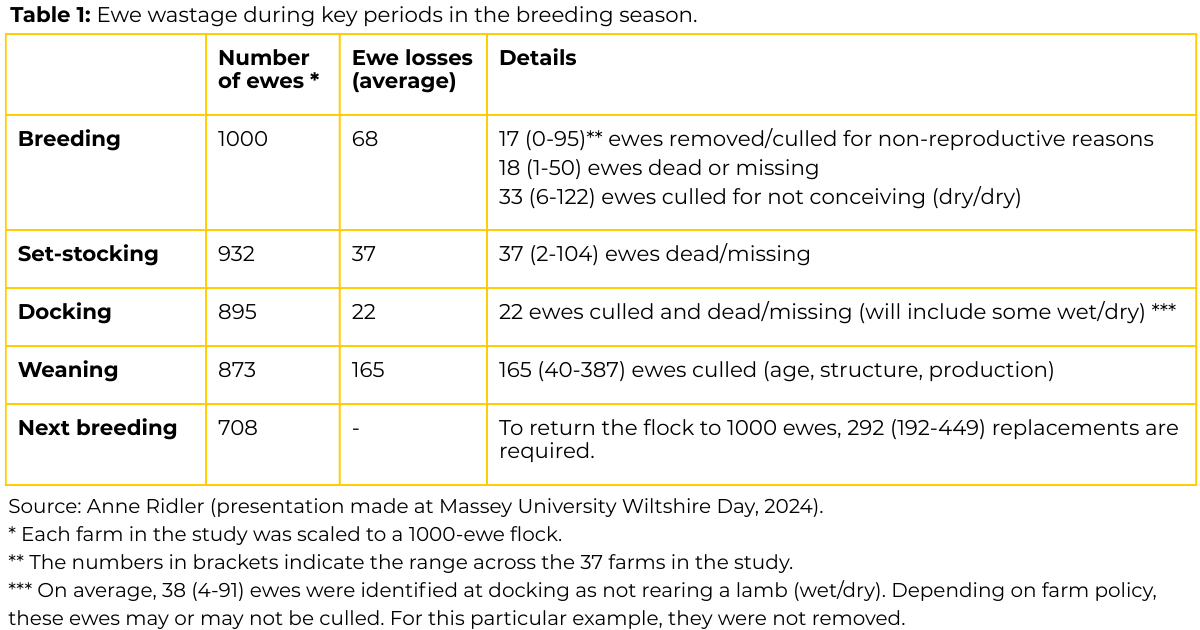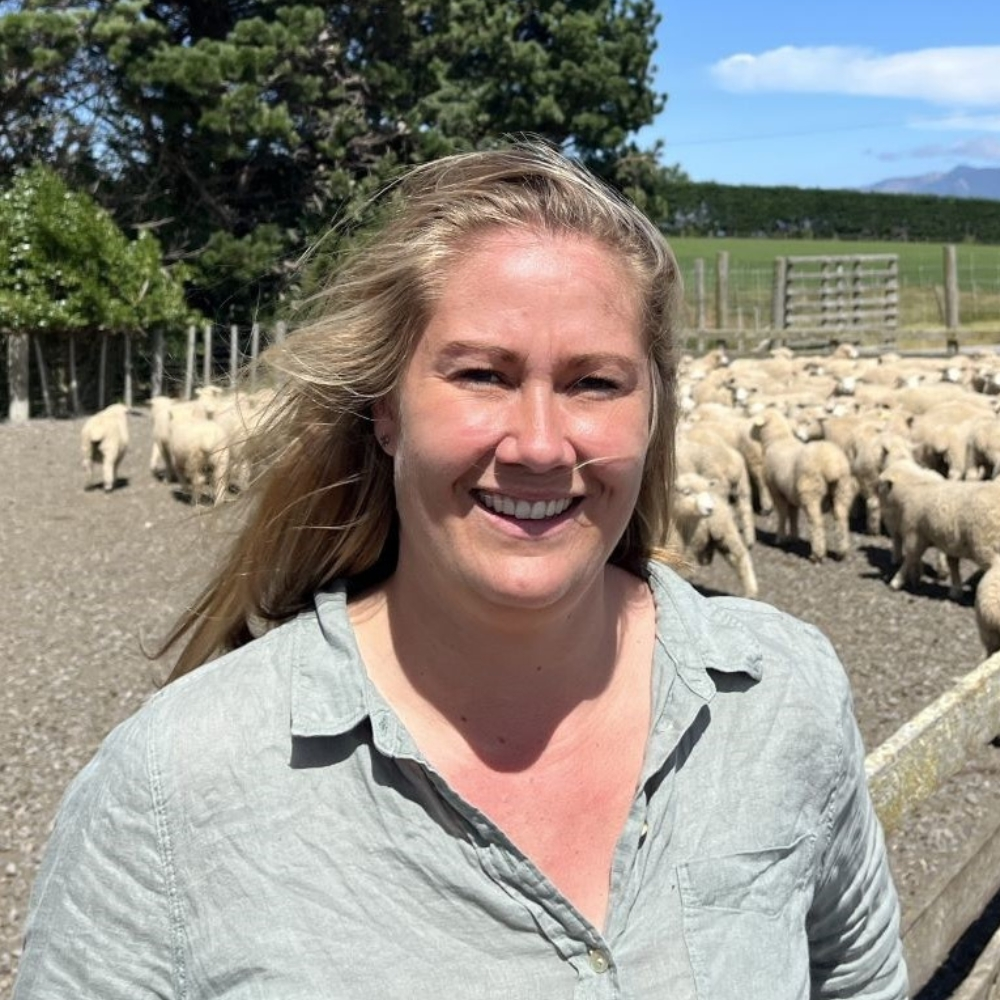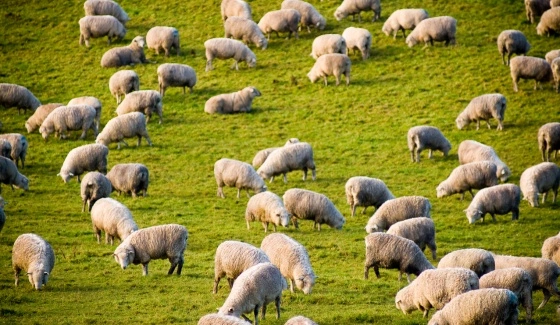
We all know the old saying, ‘If you’ve got livestock, you’ve got dead stock,’ but do you monitor the impact your ewe wastage rate has on your flock? Ewe wastage refers to a breeding ewe leaving the flock prior to being culled for age, either in the form of culling for non-production or faults, or death. Each ewe that departs the flock prematurely needs to be replaced with a ewe lamb to maintain breeding ewe numbers.
Adding up the cost of ewe losses
Ideally, the ewe produces one ewe lamb to replace herself, and all other progeny are terminal (i.e. make you money). If a ewe departs the flock before being culled for age, she is producing fewer profit-making lambs, and the rate of turnover happens faster. Replacements are costly animals, needing to be carried through and fed well to reach their productive potential, even during tight times, and have higher animal health costs. Reducing the turnover rate can reduce these costs.
In addition to the increased feed, management and animal health costs associated with growing replacement ewe lambs, here are some other ways that losing a ewe prematurely can decrease the productivity and profitability of the flock:
- The mature ewe is worth less at sale than a prime lamb (and worth zero if she dies in the paddock).
- The replacement ewe lamb is removed from the pool of sale lambs.
- Production from a ewe lamb is lower than that of a mature ewe.
- Retaining more youngstock means more drench is used, potentially causing issues with drench resistance on the property.
- Selecting more replacements reduces the selection pressure across the flock.
- A lower lifetime output from the lost ewe means an increase in greenhouse gas emissions per unit of product leaving the farm.
- Producing more (slower-growing) maternal-breed lambs to generate replacements means fewer (higher-growth) terminal-breed lambs being produced.
Getting to the bottom of ewe wastage
Identifying the causes of ewe loss in your flock is the first step in reducing the wastage. A study by Anne Ridler, looking at the wastage rates on 37 New Zealand sheep farms, identified some interesting stats. On average, the wastage rate was 30%, with a range of 19.2% to 44.9%.
Let’s break that down over the course of a production cycle:

This means that nearly 30% of the average ewe flock is replaced each year, with less than 16.5% culled for age (assuming some of the 165 are culled for udders, teeth, and feet in the period between weaning and breeding). This means that close to 50% of ewe losses on-farm each year are for non-production, faults or death.
Modelling shows that a North Island hill country sheep farm in New Zealand with a 21% ewe replacement rate could increase cash profit by up to 33% if ewe wastage was reduced by 5% (Farrell et al., 2019). A little reduction in ewe wastage can go a long way to increase cash profits on-farm.
Factors contributing to ewe wastage
Body condition score (BCS)
Weaning is when the recovery period begins for the next season. Ewes with a lower pre-mating BCS are more likely to depart the flock prematurely (Flay et al., 2021). Scoring body condition at weaning and identifying those that are in poor condition for preferential feeding prior to the next mating can reduce wastage rates.
Increased BCS at breeding has been shown to increase reproductive rates for ewes, until they reach a BCS of about 3.5-4. Above that, there is no further benefit in reproductive performance. Either being in a higher condition at breeding (those already at 3-4) or having an increase in BCS prior to mating (known as the flushing effect) can increase reproductive performance, compared with ewes that have a constant lower BCS.
Hogget lambing
Flay et al also indicated that lambing as a ewe lamb can increase the ewe’s chances of departing the flock prematurely. Lambing as a ewe hogget directly increases wastage rates, as there are higher mortality rates at lambing time in the younger ewes. Also, if ewe lambs are not managed well during their pregnancy, they have a reduced lifetime performance. However, lambing as a ewe lamb has a much lower effect on overall survival if the ewe lambs are grown well prior to breeding, and managed well through pregnancy and lactation. This highlights the importance of getting ewe lambs up to target weights both prior to breeding and during pregnancy to ensure successful lifetime reproductive performance.
Culling policy
Culling policy can be a bit of a personal preference, and depending on the year, it can change to match the season. General non-negotiables are ewes that have udders that have failed in some way and won’t rear a lamb next season, teeth with too much wear to allow them to meet their basic nutritional needs, and ewes that have had a prolapse during the lambing period. There may be other traits to cull on, like poor condition, poor foot structure, temperament, undesirable traits such as dags, or other reasons. Culling for not rearing a lamb (wet/dry) can be season dependent, and often these ewes are demoted to a B Flock if kept. Downgrading ewes to the B flock for undesirable traits that are heritable can prevent them from passing them on to future replacements.
Remember that most culled ewes still retain some form of value, whether that be the works value, or the value of using her to feed dogs.
Premature ewe deaths
There are two guarantees in life: death and taxes. Your sheep aren’t particularly worried by taxes, but some ewe deaths are avoidable. Ewe deaths are the most costly aspect of ewe wastage, with zero recovery value. They usually occur around the lambing period, often resulting in lamb wastage as well. This will incur feed, management and animal health costs for the year with zero return. Focusing on reducing ewe deaths can be the most cost-effective way to reduce wastage.
Keeping ewes in optimal BCS and nutritional state, especially through pregnancy and lactation, can help to reduce the risk of premature death of the ewe (and her lambs). Monitoring ewes more closely during pivotal periods can help to reduce ewe deaths by allowing you to intervene if necessary. Becoming cast is the most avoidable way for a ewe to die, so doing a cast beat can be a worthwhile effort to decrease the wastage rate in your ewe flock.
Keeping tally and taking action
All in all, some ewe losses are inevitable on-farm, but reducing the number of ewes that are dying or being culled prematurely can increase farm productivity and decrease the number of replacements required each year. Accurately recording ewe tallies throughout the year allows you to pinpoint where in the production cycle you can improve your management to minimise wastage.
- Maintaining ewes in good body condition by monitoring BCS and managing the ewes to their needs can reduce unnecessary ewe deaths.
- In some cases, higher culling rates earlier on can reduce the number of poorer animals passing on their genes. Selecting more replacements from a smaller pool of higher-quality sheep may be the answer in the long term.
- Decisions on culling and replacement selection should be based on some fundamental policies, but have the ability to adapt to either a bumper or a tight season.
Remember, the replacements that you select this year will be the ewes that you have to choose to keep or cull in the future, so make informed decisions.
________
Join the conversation on The Hub
Take a moment to head over to the neXtgen Agri Hub to share your reflections and questions. We’d love to hear your thoughts on reducing ewe losses.
________
Further reading




.webp)




